Report on Implementing Hospital OS for Royal Adelaide Hospital System
VerifiedAdded on 2020/03/23
|11
|2518
|141
Report
AI Summary
This report focuses on implementing a new information system, Hospital OS, for the Royal Adelaide Hospital. It addresses the need for a modern system to replace outdated methods and improve patient care, incorporating robotics, patient records, and other key hospital functions. The report provides an overview of the Hospital OS, its features, advantages, and disadvantages. It includes a feasibility study, examining technological, operational, economic, schedule, social, and legal aspects of the implementation. Recommendations are made for successful implementation, including staff training and departmental integration. The report concludes that Hospital OS is a suitable solution for computerizing the hospital's operations, improving information storage, and enhancing overall efficiency. The references include a range of scholarly articles related to information systems, health informatics, and hospital management.
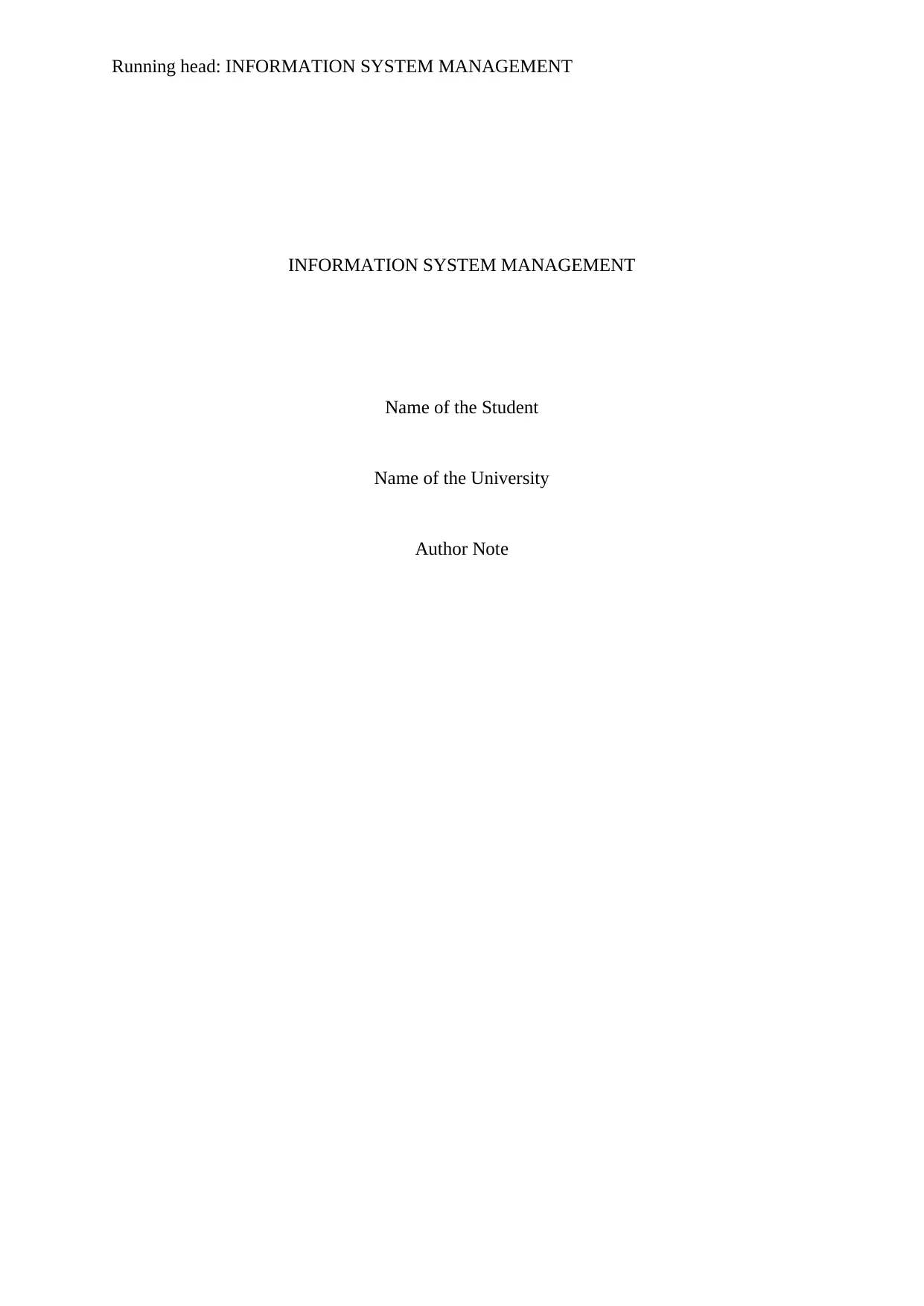
Running head: INFORMATION SYSTEM MANAGEMENT
INFORMATION SYSTEM MANAGEMENT
Name of the Student
Name of the University
Author Note
INFORMATION SYSTEM MANAGEMENT
Name of the Student
Name of the University
Author Note
Paraphrase This Document
Need a fresh take? Get an instant paraphrase of this document with our AI Paraphraser
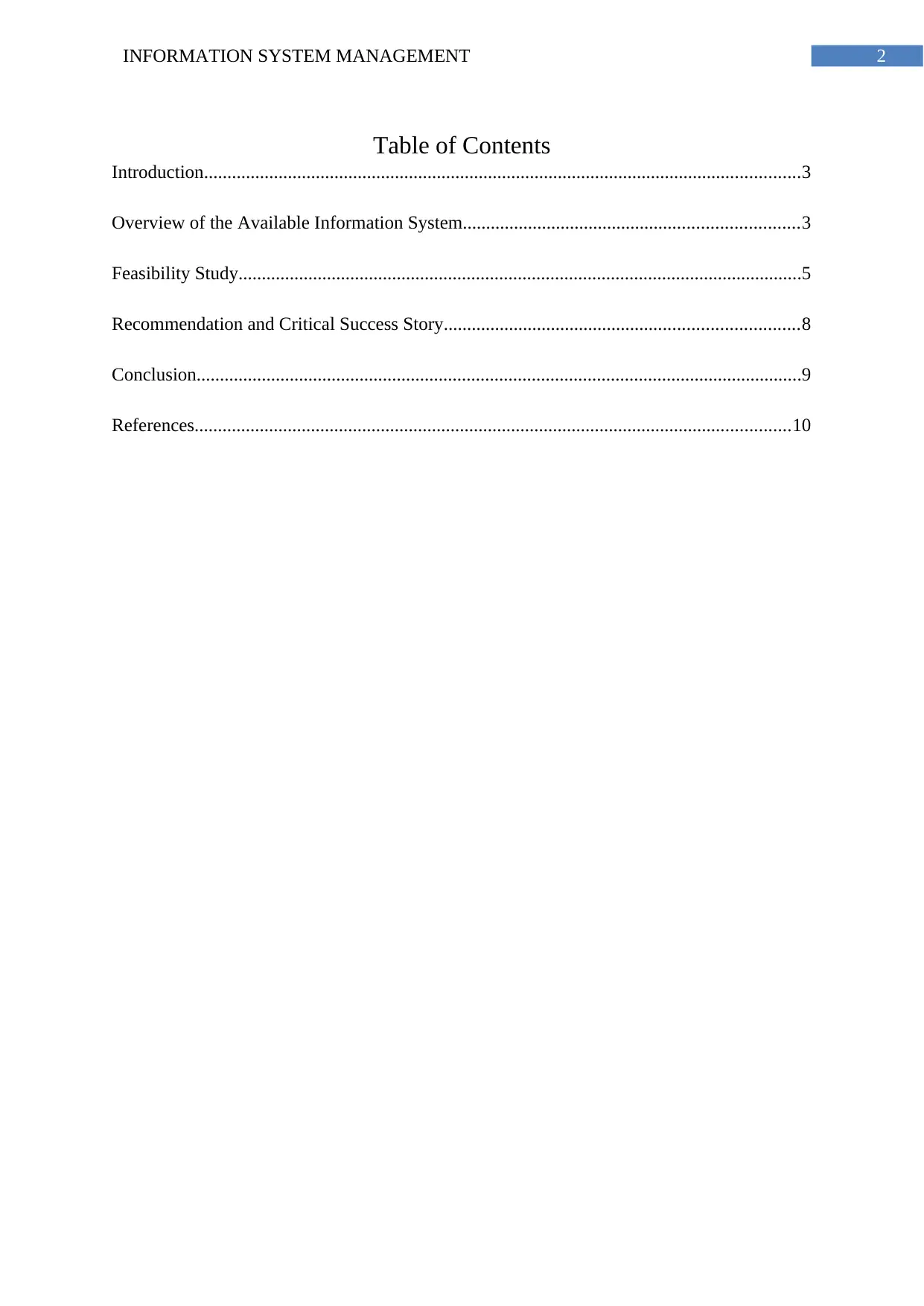
2INFORMATION SYSTEM MANAGEMENT
Table of Contents
Introduction................................................................................................................................3
Overview of the Available Information System........................................................................3
Feasibility Study.........................................................................................................................5
Recommendation and Critical Success Story............................................................................8
Conclusion..................................................................................................................................9
References................................................................................................................................10
Table of Contents
Introduction................................................................................................................................3
Overview of the Available Information System........................................................................3
Feasibility Study.........................................................................................................................5
Recommendation and Critical Success Story............................................................................8
Conclusion..................................................................................................................................9
References................................................................................................................................10
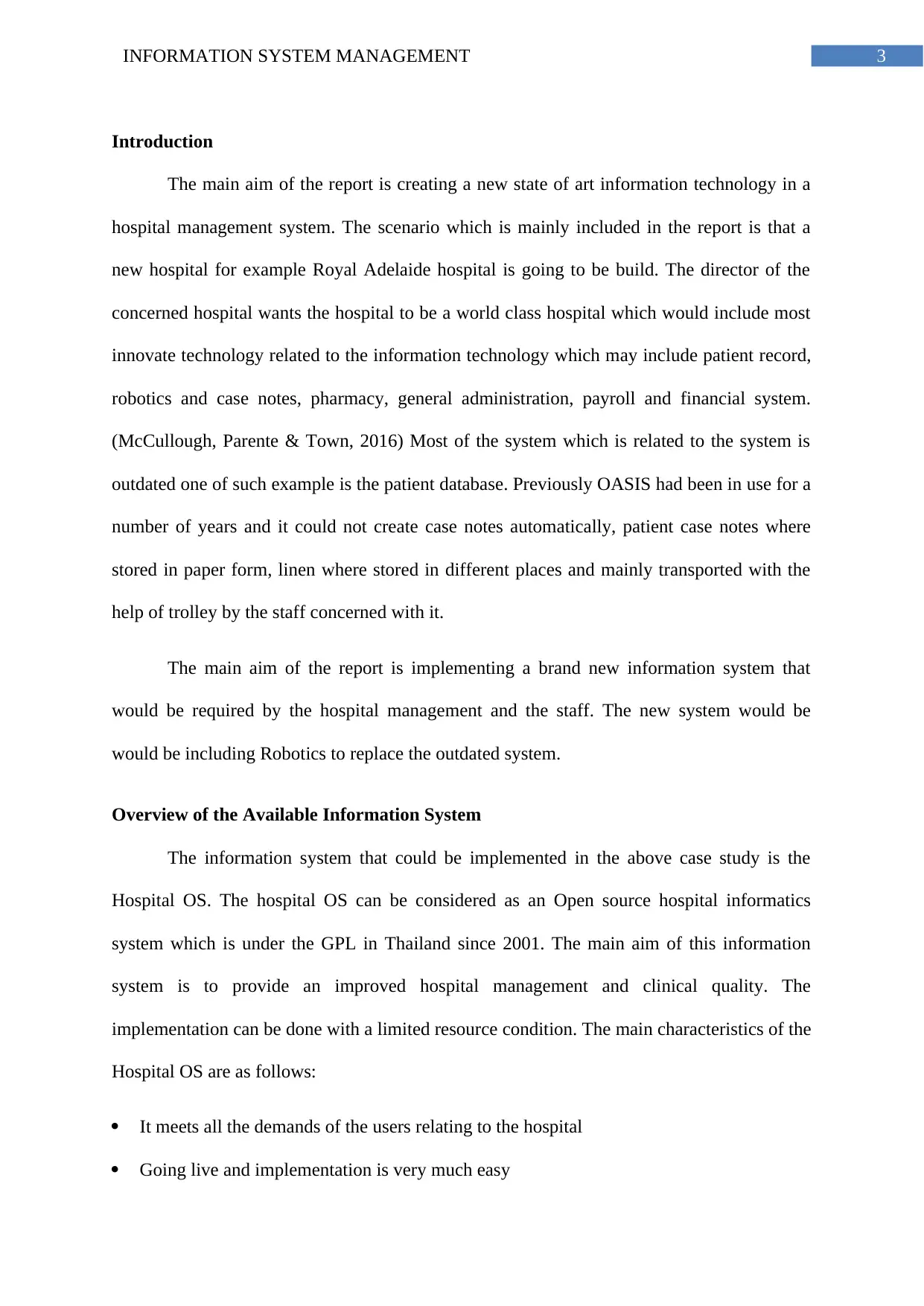
3INFORMATION SYSTEM MANAGEMENT
Introduction
The main aim of the report is creating a new state of art information technology in a
hospital management system. The scenario which is mainly included in the report is that a
new hospital for example Royal Adelaide hospital is going to be build. The director of the
concerned hospital wants the hospital to be a world class hospital which would include most
innovate technology related to the information technology which may include patient record,
robotics and case notes, pharmacy, general administration, payroll and financial system.
(McCullough, Parente & Town, 2016) Most of the system which is related to the system is
outdated one of such example is the patient database. Previously OASIS had been in use for a
number of years and it could not create case notes automatically, patient case notes where
stored in paper form, linen where stored in different places and mainly transported with the
help of trolley by the staff concerned with it.
The main aim of the report is implementing a brand new information system that
would be required by the hospital management and the staff. The new system would be
would be including Robotics to replace the outdated system.
Overview of the Available Information System
The information system that could be implemented in the above case study is the
Hospital OS. The hospital OS can be considered as an Open source hospital informatics
system which is under the GPL in Thailand since 2001. The main aim of this information
system is to provide an improved hospital management and clinical quality. The
implementation can be done with a limited resource condition. The main characteristics of the
Hospital OS are as follows:
It meets all the demands of the users relating to the hospital
Going live and implementation is very much easy
Introduction
The main aim of the report is creating a new state of art information technology in a
hospital management system. The scenario which is mainly included in the report is that a
new hospital for example Royal Adelaide hospital is going to be build. The director of the
concerned hospital wants the hospital to be a world class hospital which would include most
innovate technology related to the information technology which may include patient record,
robotics and case notes, pharmacy, general administration, payroll and financial system.
(McCullough, Parente & Town, 2016) Most of the system which is related to the system is
outdated one of such example is the patient database. Previously OASIS had been in use for a
number of years and it could not create case notes automatically, patient case notes where
stored in paper form, linen where stored in different places and mainly transported with the
help of trolley by the staff concerned with it.
The main aim of the report is implementing a brand new information system that
would be required by the hospital management and the staff. The new system would be
would be including Robotics to replace the outdated system.
Overview of the Available Information System
The information system that could be implemented in the above case study is the
Hospital OS. The hospital OS can be considered as an Open source hospital informatics
system which is under the GPL in Thailand since 2001. The main aim of this information
system is to provide an improved hospital management and clinical quality. The
implementation can be done with a limited resource condition. The main characteristics of the
Hospital OS are as follows:
It meets all the demands of the users relating to the hospital
Going live and implementation is very much easy
⊘ This is a preview!⊘
Do you want full access?
Subscribe today to unlock all pages.

Trusted by 1+ million students worldwide
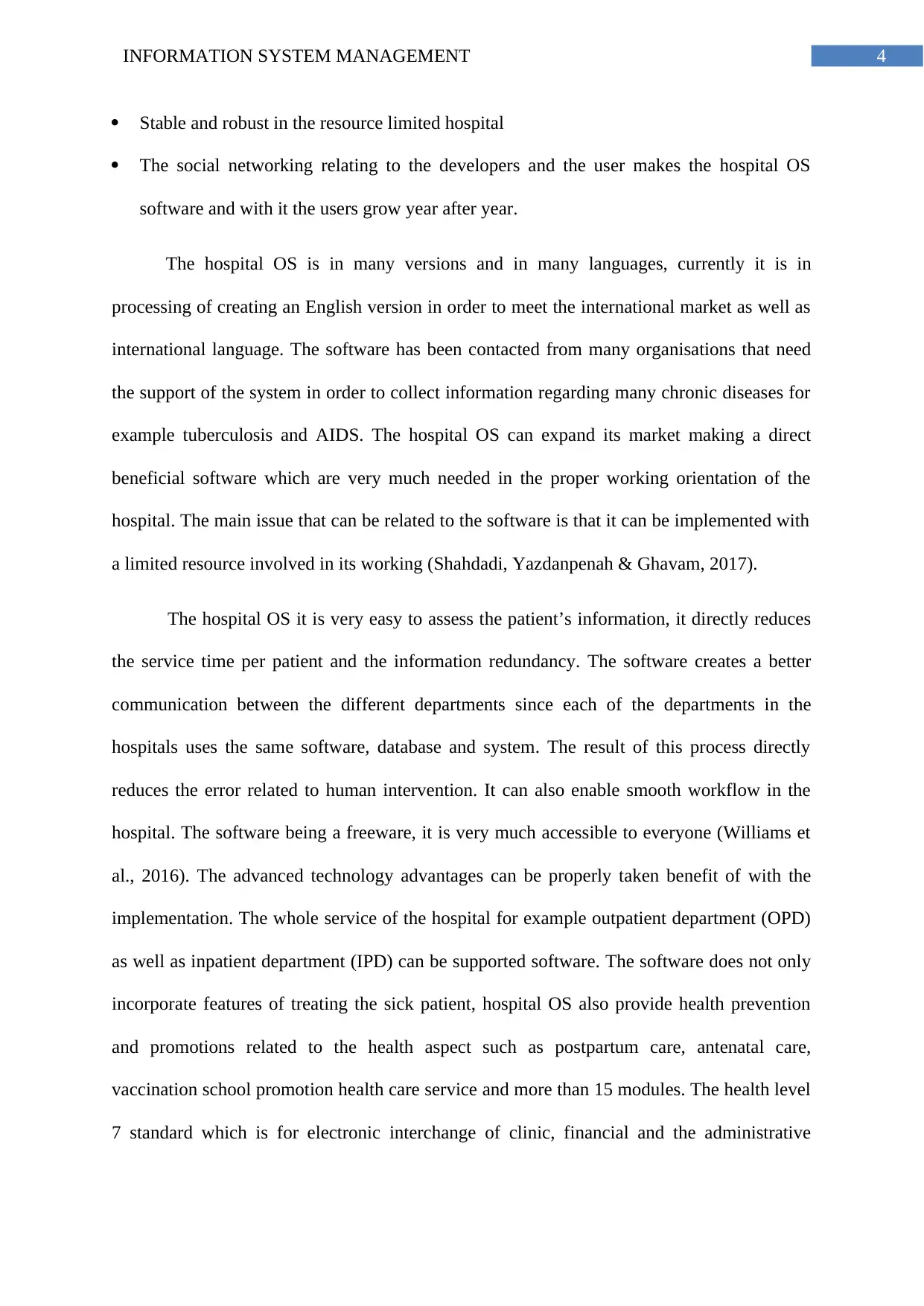
4INFORMATION SYSTEM MANAGEMENT
Stable and robust in the resource limited hospital
The social networking relating to the developers and the user makes the hospital OS
software and with it the users grow year after year.
The hospital OS is in many versions and in many languages, currently it is in
processing of creating an English version in order to meet the international market as well as
international language. The software has been contacted from many organisations that need
the support of the system in order to collect information regarding many chronic diseases for
example tuberculosis and AIDS. The hospital OS can expand its market making a direct
beneficial software which are very much needed in the proper working orientation of the
hospital. The main issue that can be related to the software is that it can be implemented with
a limited resource involved in its working (Shahdadi, Yazdanpenah & Ghavam, 2017).
The hospital OS it is very easy to assess the patient’s information, it directly reduces
the service time per patient and the information redundancy. The software creates a better
communication between the different departments since each of the departments in the
hospitals uses the same software, database and system. The result of this process directly
reduces the error related to human intervention. It can also enable smooth workflow in the
hospital. The software being a freeware, it is very much accessible to everyone (Williams et
al., 2016). The advanced technology advantages can be properly taken benefit of with the
implementation. The whole service of the hospital for example outpatient department (OPD)
as well as inpatient department (IPD) can be supported software. The software does not only
incorporate features of treating the sick patient, hospital OS also provide health prevention
and promotions related to the health aspect such as postpartum care, antenatal care,
vaccination school promotion health care service and more than 15 modules. The health level
7 standard which is for electronic interchange of clinic, financial and the administrative
Stable and robust in the resource limited hospital
The social networking relating to the developers and the user makes the hospital OS
software and with it the users grow year after year.
The hospital OS is in many versions and in many languages, currently it is in
processing of creating an English version in order to meet the international market as well as
international language. The software has been contacted from many organisations that need
the support of the system in order to collect information regarding many chronic diseases for
example tuberculosis and AIDS. The hospital OS can expand its market making a direct
beneficial software which are very much needed in the proper working orientation of the
hospital. The main issue that can be related to the software is that it can be implemented with
a limited resource involved in its working (Shahdadi, Yazdanpenah & Ghavam, 2017).
The hospital OS it is very easy to assess the patient’s information, it directly reduces
the service time per patient and the information redundancy. The software creates a better
communication between the different departments since each of the departments in the
hospitals uses the same software, database and system. The result of this process directly
reduces the error related to human intervention. It can also enable smooth workflow in the
hospital. The software being a freeware, it is very much accessible to everyone (Williams et
al., 2016). The advanced technology advantages can be properly taken benefit of with the
implementation. The whole service of the hospital for example outpatient department (OPD)
as well as inpatient department (IPD) can be supported software. The software does not only
incorporate features of treating the sick patient, hospital OS also provide health prevention
and promotions related to the health aspect such as postpartum care, antenatal care,
vaccination school promotion health care service and more than 15 modules. The health level
7 standard which is for electronic interchange of clinic, financial and the administrative
Paraphrase This Document
Need a fresh take? Get an instant paraphrase of this document with our AI Paraphraser
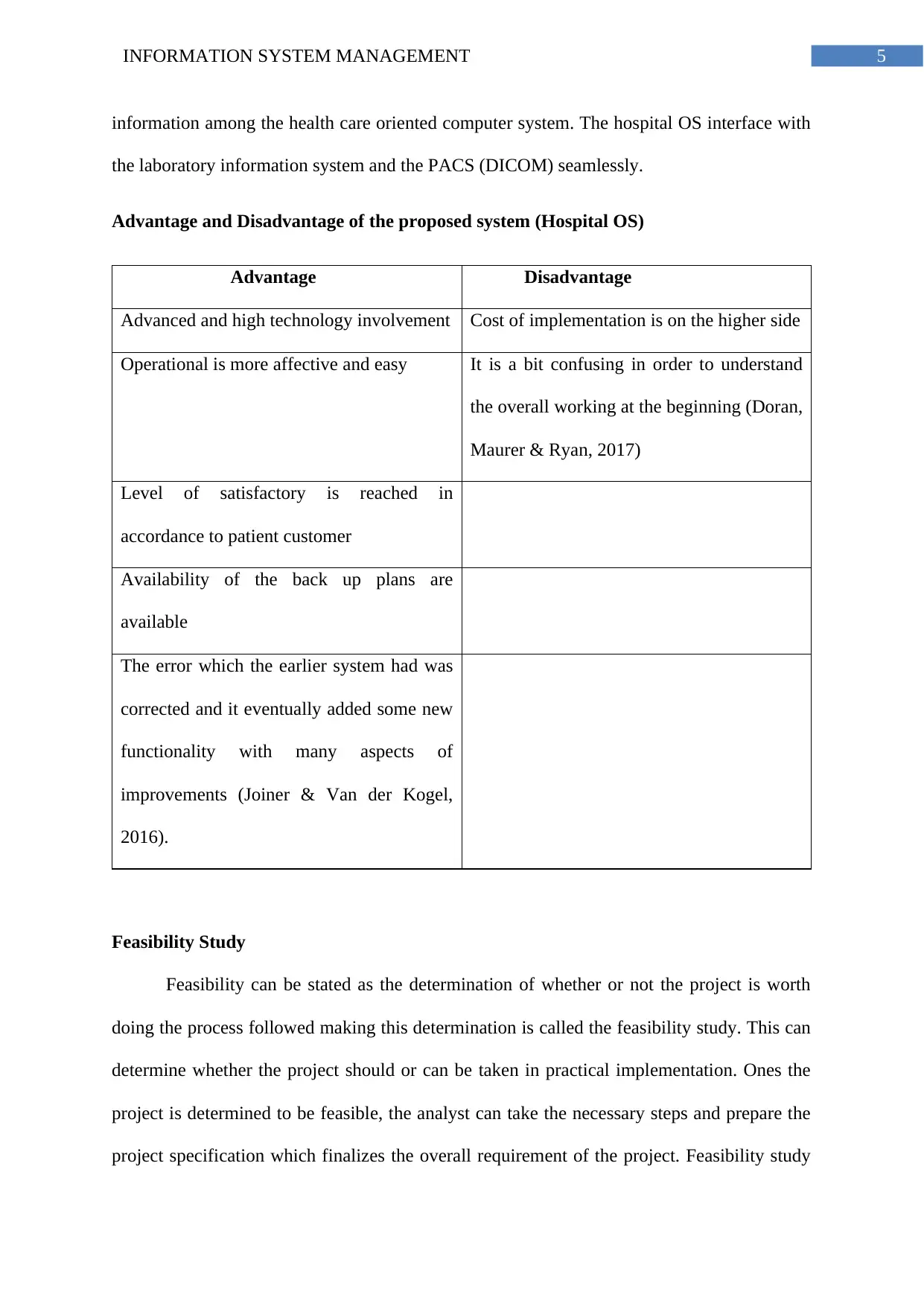
5INFORMATION SYSTEM MANAGEMENT
information among the health care oriented computer system. The hospital OS interface with
the laboratory information system and the PACS (DICOM) seamlessly.
Advantage and Disadvantage of the proposed system (Hospital OS)
Advantage Disadvantage
Advanced and high technology involvement Cost of implementation is on the higher side
Operational is more affective and easy It is a bit confusing in order to understand
the overall working at the beginning (Doran,
Maurer & Ryan, 2017)
Level of satisfactory is reached in
accordance to patient customer
Availability of the back up plans are
available
The error which the earlier system had was
corrected and it eventually added some new
functionality with many aspects of
improvements (Joiner & Van der Kogel,
2016).
Feasibility Study
Feasibility can be stated as the determination of whether or not the project is worth
doing the process followed making this determination is called the feasibility study. This can
determine whether the project should or can be taken in practical implementation. Ones the
project is determined to be feasible, the analyst can take the necessary steps and prepare the
project specification which finalizes the overall requirement of the project. Feasibility study
information among the health care oriented computer system. The hospital OS interface with
the laboratory information system and the PACS (DICOM) seamlessly.
Advantage and Disadvantage of the proposed system (Hospital OS)
Advantage Disadvantage
Advanced and high technology involvement Cost of implementation is on the higher side
Operational is more affective and easy It is a bit confusing in order to understand
the overall working at the beginning (Doran,
Maurer & Ryan, 2017)
Level of satisfactory is reached in
accordance to patient customer
Availability of the back up plans are
available
The error which the earlier system had was
corrected and it eventually added some new
functionality with many aspects of
improvements (Joiner & Van der Kogel,
2016).
Feasibility Study
Feasibility can be stated as the determination of whether or not the project is worth
doing the process followed making this determination is called the feasibility study. This can
determine whether the project should or can be taken in practical implementation. Ones the
project is determined to be feasible, the analyst can take the necessary steps and prepare the
project specification which finalizes the overall requirement of the project. Feasibility study
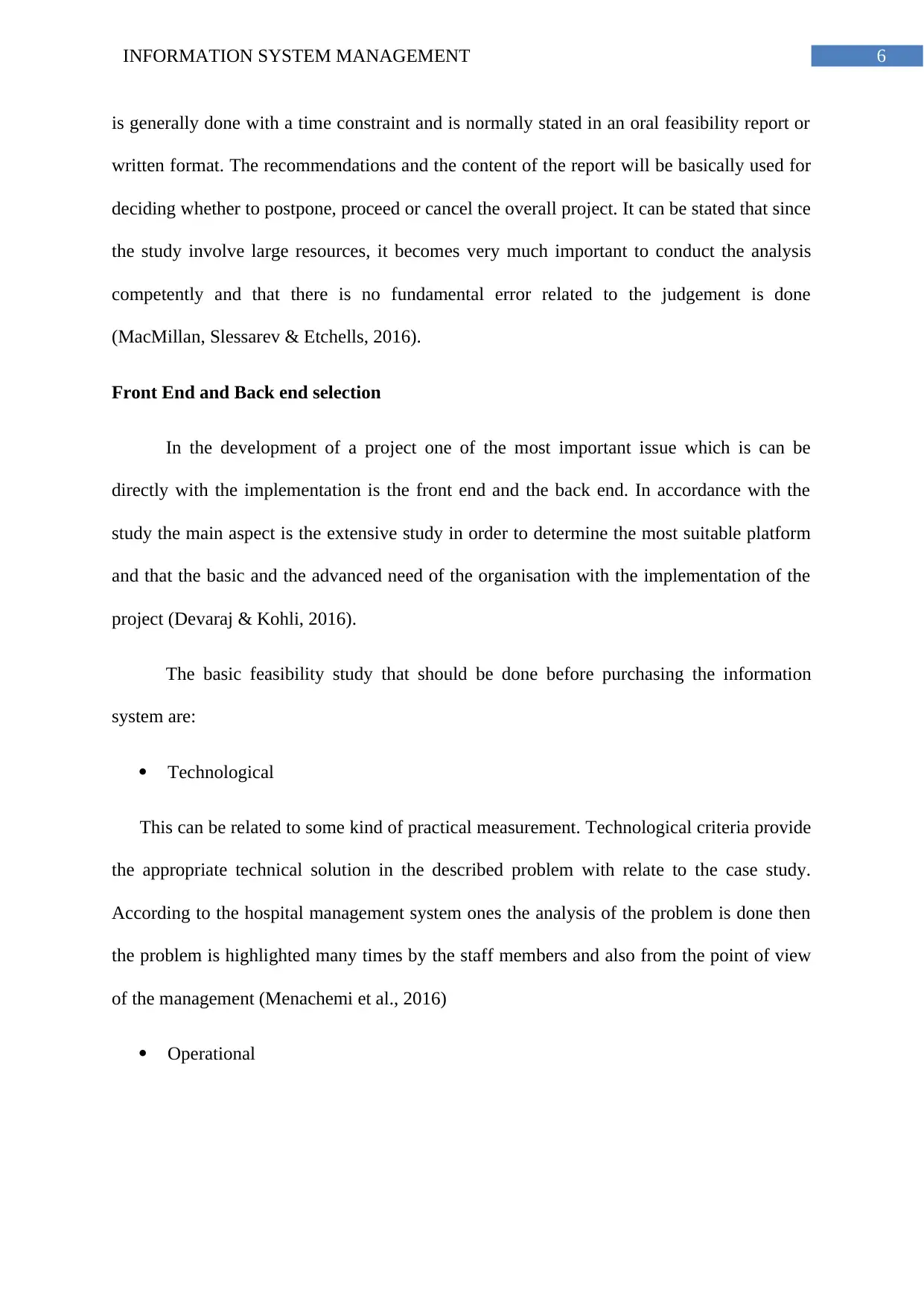
6INFORMATION SYSTEM MANAGEMENT
is generally done with a time constraint and is normally stated in an oral feasibility report or
written format. The recommendations and the content of the report will be basically used for
deciding whether to postpone, proceed or cancel the overall project. It can be stated that since
the study involve large resources, it becomes very much important to conduct the analysis
competently and that there is no fundamental error related to the judgement is done
(MacMillan, Slessarev & Etchells, 2016).
Front End and Back end selection
In the development of a project one of the most important issue which is can be
directly with the implementation is the front end and the back end. In accordance with the
study the main aspect is the extensive study in order to determine the most suitable platform
and that the basic and the advanced need of the organisation with the implementation of the
project (Devaraj & Kohli, 2016).
The basic feasibility study that should be done before purchasing the information
system are:
Technological
This can be related to some kind of practical measurement. Technological criteria provide
the appropriate technical solution in the described problem with relate to the case study.
According to the hospital management system ones the analysis of the problem is done then
the problem is highlighted many times by the staff members and also from the point of view
of the management (Menachemi et al., 2016)
Operational
is generally done with a time constraint and is normally stated in an oral feasibility report or
written format. The recommendations and the content of the report will be basically used for
deciding whether to postpone, proceed or cancel the overall project. It can be stated that since
the study involve large resources, it becomes very much important to conduct the analysis
competently and that there is no fundamental error related to the judgement is done
(MacMillan, Slessarev & Etchells, 2016).
Front End and Back end selection
In the development of a project one of the most important issue which is can be
directly with the implementation is the front end and the back end. In accordance with the
study the main aspect is the extensive study in order to determine the most suitable platform
and that the basic and the advanced need of the organisation with the implementation of the
project (Devaraj & Kohli, 2016).
The basic feasibility study that should be done before purchasing the information
system are:
Technological
This can be related to some kind of practical measurement. Technological criteria provide
the appropriate technical solution in the described problem with relate to the case study.
According to the hospital management system ones the analysis of the problem is done then
the problem is highlighted many times by the staff members and also from the point of view
of the management (Menachemi et al., 2016)
Operational
⊘ This is a preview!⊘
Do you want full access?
Subscribe today to unlock all pages.

Trusted by 1+ million students worldwide
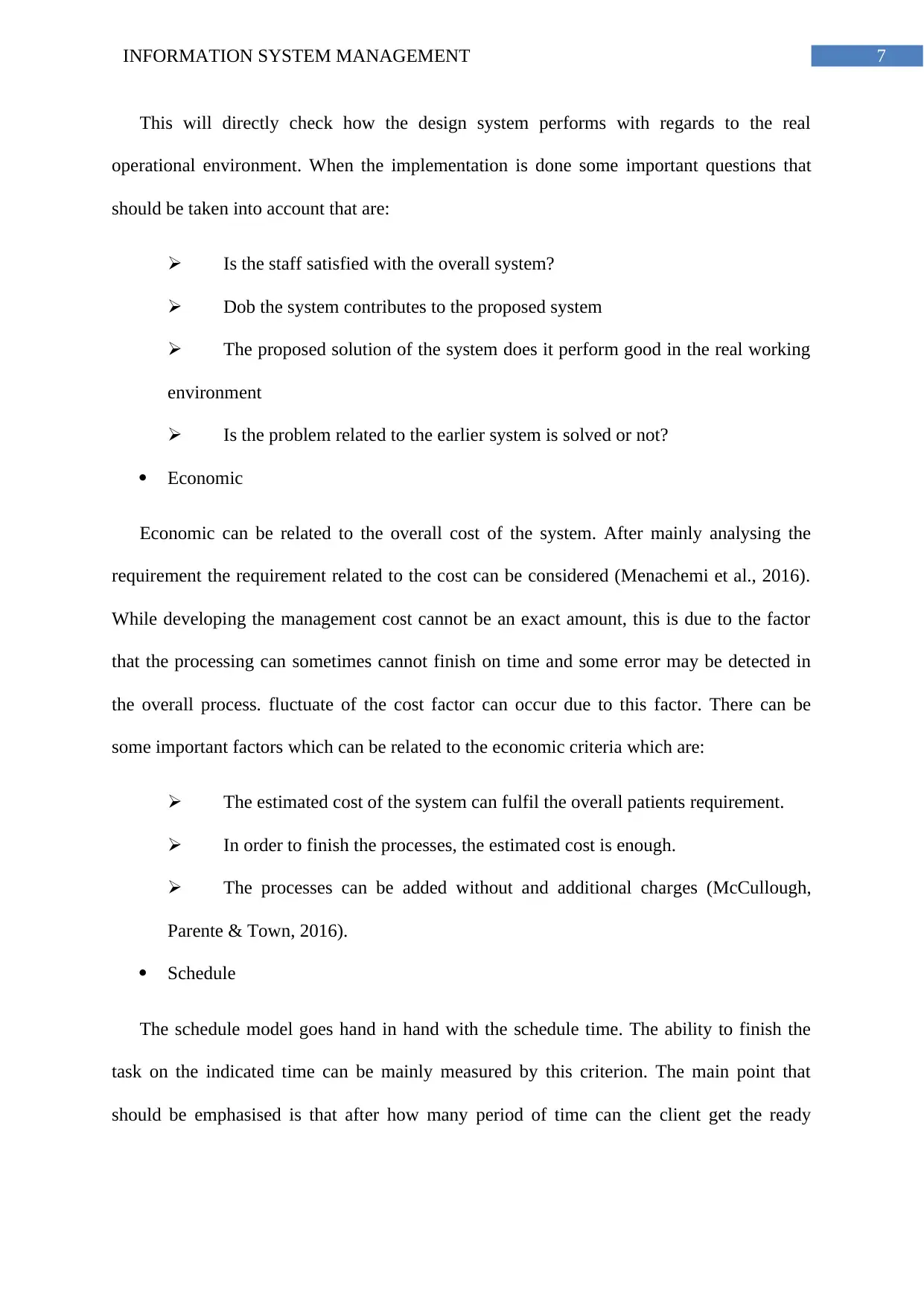
7INFORMATION SYSTEM MANAGEMENT
This will directly check how the design system performs with regards to the real
operational environment. When the implementation is done some important questions that
should be taken into account that are:
Is the staff satisfied with the overall system?
Dob the system contributes to the proposed system
The proposed solution of the system does it perform good in the real working
environment
Is the problem related to the earlier system is solved or not?
Economic
Economic can be related to the overall cost of the system. After mainly analysing the
requirement the requirement related to the cost can be considered (Menachemi et al., 2016).
While developing the management cost cannot be an exact amount, this is due to the factor
that the processing can sometimes cannot finish on time and some error may be detected in
the overall process. fluctuate of the cost factor can occur due to this factor. There can be
some important factors which can be related to the economic criteria which are:
The estimated cost of the system can fulfil the overall patients requirement.
In order to finish the processes, the estimated cost is enough.
The processes can be added without and additional charges (McCullough,
Parente & Town, 2016).
Schedule
The schedule model goes hand in hand with the schedule time. The ability to finish the
task on the indicated time can be mainly measured by this criterion. The main point that
should be emphasised is that after how many period of time can the client get the ready
This will directly check how the design system performs with regards to the real
operational environment. When the implementation is done some important questions that
should be taken into account that are:
Is the staff satisfied with the overall system?
Dob the system contributes to the proposed system
The proposed solution of the system does it perform good in the real working
environment
Is the problem related to the earlier system is solved or not?
Economic
Economic can be related to the overall cost of the system. After mainly analysing the
requirement the requirement related to the cost can be considered (Menachemi et al., 2016).
While developing the management cost cannot be an exact amount, this is due to the factor
that the processing can sometimes cannot finish on time and some error may be detected in
the overall process. fluctuate of the cost factor can occur due to this factor. There can be
some important factors which can be related to the economic criteria which are:
The estimated cost of the system can fulfil the overall patients requirement.
In order to finish the processes, the estimated cost is enough.
The processes can be added without and additional charges (McCullough,
Parente & Town, 2016).
Schedule
The schedule model goes hand in hand with the schedule time. The ability to finish the
task on the indicated time can be mainly measured by this criterion. The main point that
should be emphasised is that after how many period of time can the client get the ready
Paraphrase This Document
Need a fresh take? Get an instant paraphrase of this document with our AI Paraphraser
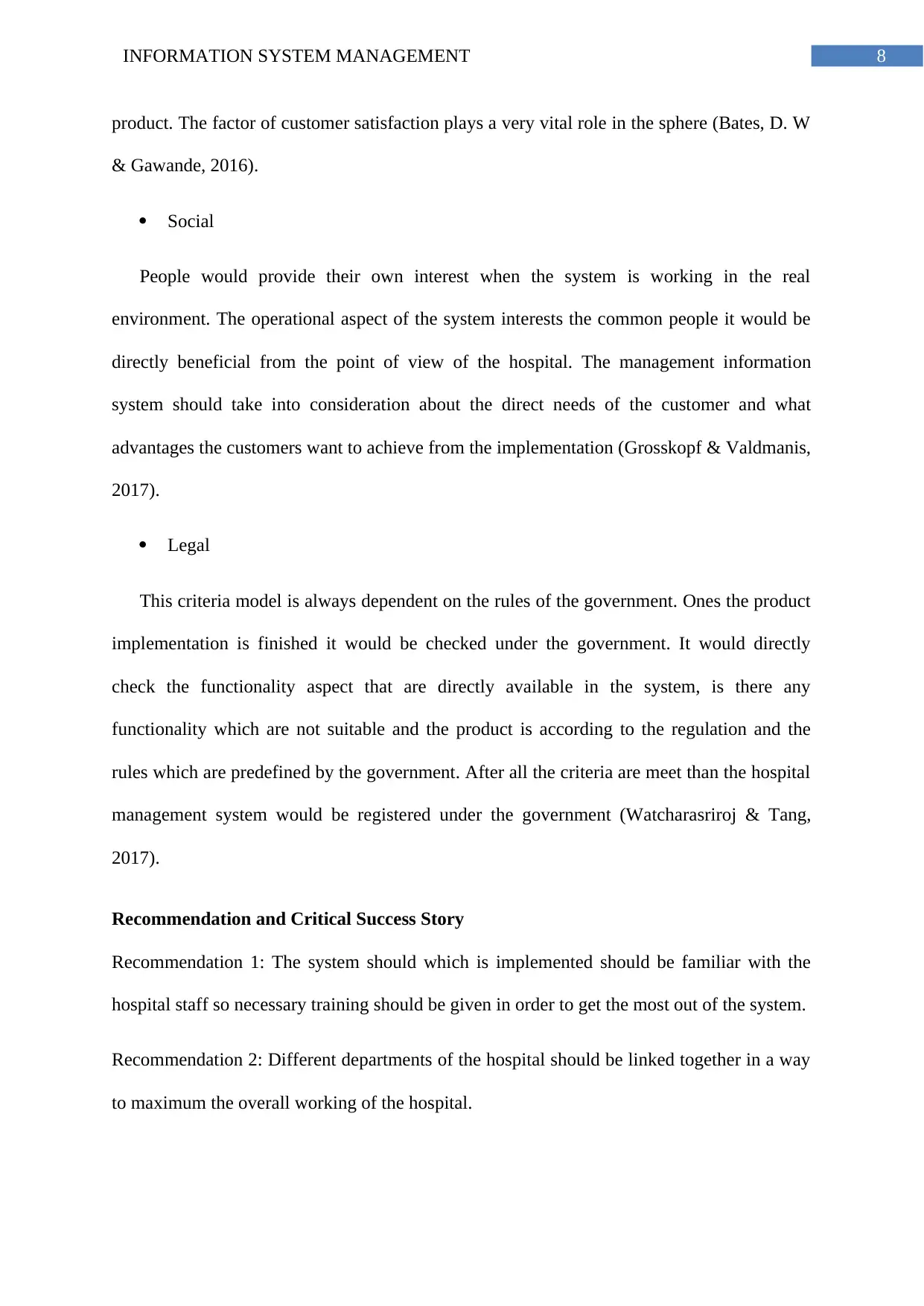
8INFORMATION SYSTEM MANAGEMENT
product. The factor of customer satisfaction plays a very vital role in the sphere (Bates, D. W
& Gawande, 2016).
Social
People would provide their own interest when the system is working in the real
environment. The operational aspect of the system interests the common people it would be
directly beneficial from the point of view of the hospital. The management information
system should take into consideration about the direct needs of the customer and what
advantages the customers want to achieve from the implementation (Grosskopf & Valdmanis,
2017).
Legal
This criteria model is always dependent on the rules of the government. Ones the product
implementation is finished it would be checked under the government. It would directly
check the functionality aspect that are directly available in the system, is there any
functionality which are not suitable and the product is according to the regulation and the
rules which are predefined by the government. After all the criteria are meet than the hospital
management system would be registered under the government (Watcharasriroj & Tang,
2017).
Recommendation and Critical Success Story
Recommendation 1: The system should which is implemented should be familiar with the
hospital staff so necessary training should be given in order to get the most out of the system.
Recommendation 2: Different departments of the hospital should be linked together in a way
to maximum the overall working of the hospital.
product. The factor of customer satisfaction plays a very vital role in the sphere (Bates, D. W
& Gawande, 2016).
Social
People would provide their own interest when the system is working in the real
environment. The operational aspect of the system interests the common people it would be
directly beneficial from the point of view of the hospital. The management information
system should take into consideration about the direct needs of the customer and what
advantages the customers want to achieve from the implementation (Grosskopf & Valdmanis,
2017).
Legal
This criteria model is always dependent on the rules of the government. Ones the product
implementation is finished it would be checked under the government. It would directly
check the functionality aspect that are directly available in the system, is there any
functionality which are not suitable and the product is according to the regulation and the
rules which are predefined by the government. After all the criteria are meet than the hospital
management system would be registered under the government (Watcharasriroj & Tang,
2017).
Recommendation and Critical Success Story
Recommendation 1: The system should which is implemented should be familiar with the
hospital staff so necessary training should be given in order to get the most out of the system.
Recommendation 2: Different departments of the hospital should be linked together in a way
to maximum the overall working of the hospital.
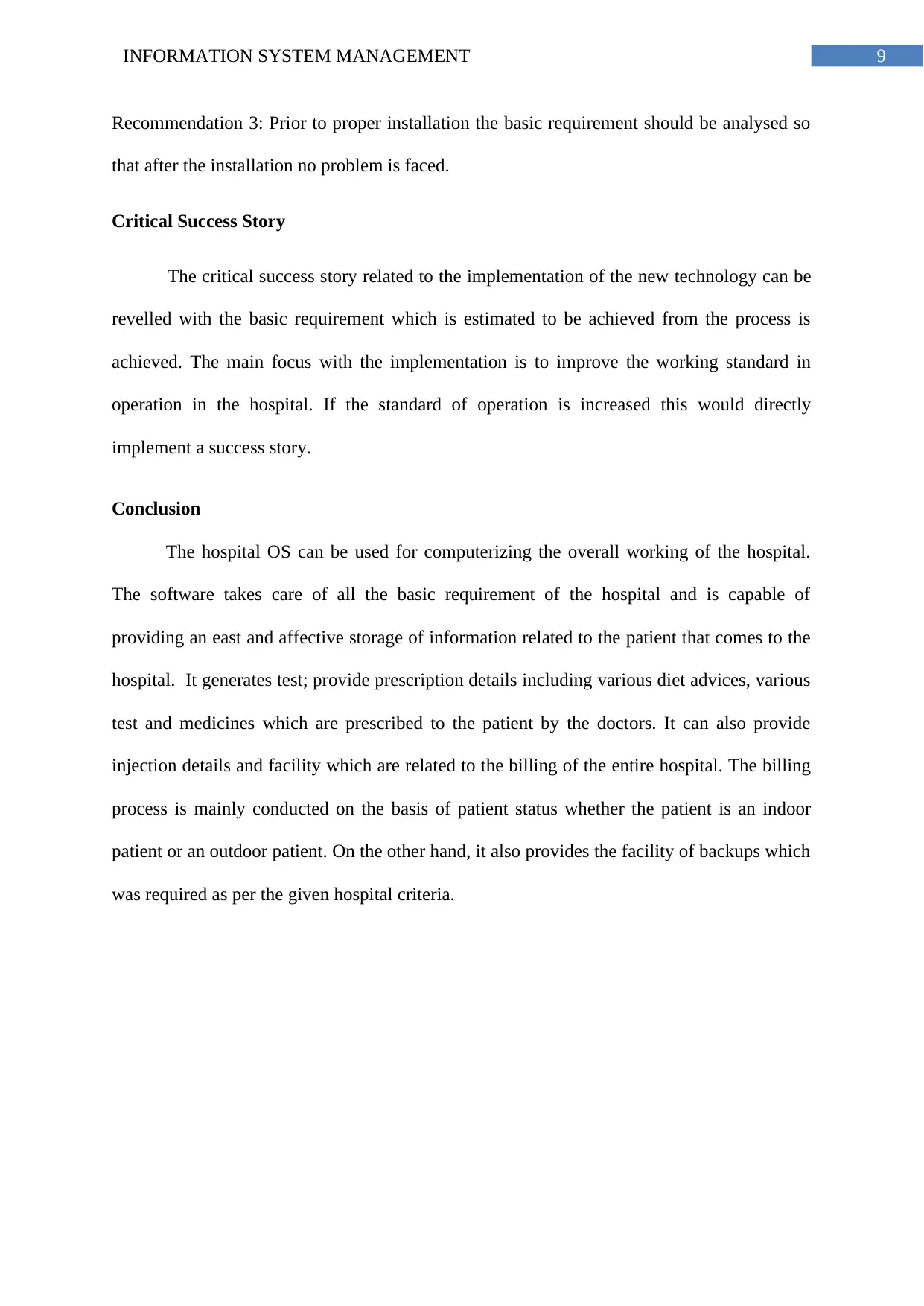
9INFORMATION SYSTEM MANAGEMENT
Recommendation 3: Prior to proper installation the basic requirement should be analysed so
that after the installation no problem is faced.
Critical Success Story
The critical success story related to the implementation of the new technology can be
revelled with the basic requirement which is estimated to be achieved from the process is
achieved. The main focus with the implementation is to improve the working standard in
operation in the hospital. If the standard of operation is increased this would directly
implement a success story.
Conclusion
The hospital OS can be used for computerizing the overall working of the hospital.
The software takes care of all the basic requirement of the hospital and is capable of
providing an east and affective storage of information related to the patient that comes to the
hospital. It generates test; provide prescription details including various diet advices, various
test and medicines which are prescribed to the patient by the doctors. It can also provide
injection details and facility which are related to the billing of the entire hospital. The billing
process is mainly conducted on the basis of patient status whether the patient is an indoor
patient or an outdoor patient. On the other hand, it also provides the facility of backups which
was required as per the given hospital criteria.
Recommendation 3: Prior to proper installation the basic requirement should be analysed so
that after the installation no problem is faced.
Critical Success Story
The critical success story related to the implementation of the new technology can be
revelled with the basic requirement which is estimated to be achieved from the process is
achieved. The main focus with the implementation is to improve the working standard in
operation in the hospital. If the standard of operation is increased this would directly
implement a success story.
Conclusion
The hospital OS can be used for computerizing the overall working of the hospital.
The software takes care of all the basic requirement of the hospital and is capable of
providing an east and affective storage of information related to the patient that comes to the
hospital. It generates test; provide prescription details including various diet advices, various
test and medicines which are prescribed to the patient by the doctors. It can also provide
injection details and facility which are related to the billing of the entire hospital. The billing
process is mainly conducted on the basis of patient status whether the patient is an indoor
patient or an outdoor patient. On the other hand, it also provides the facility of backups which
was required as per the given hospital criteria.
⊘ This is a preview!⊘
Do you want full access?
Subscribe today to unlock all pages.

Trusted by 1+ million students worldwide
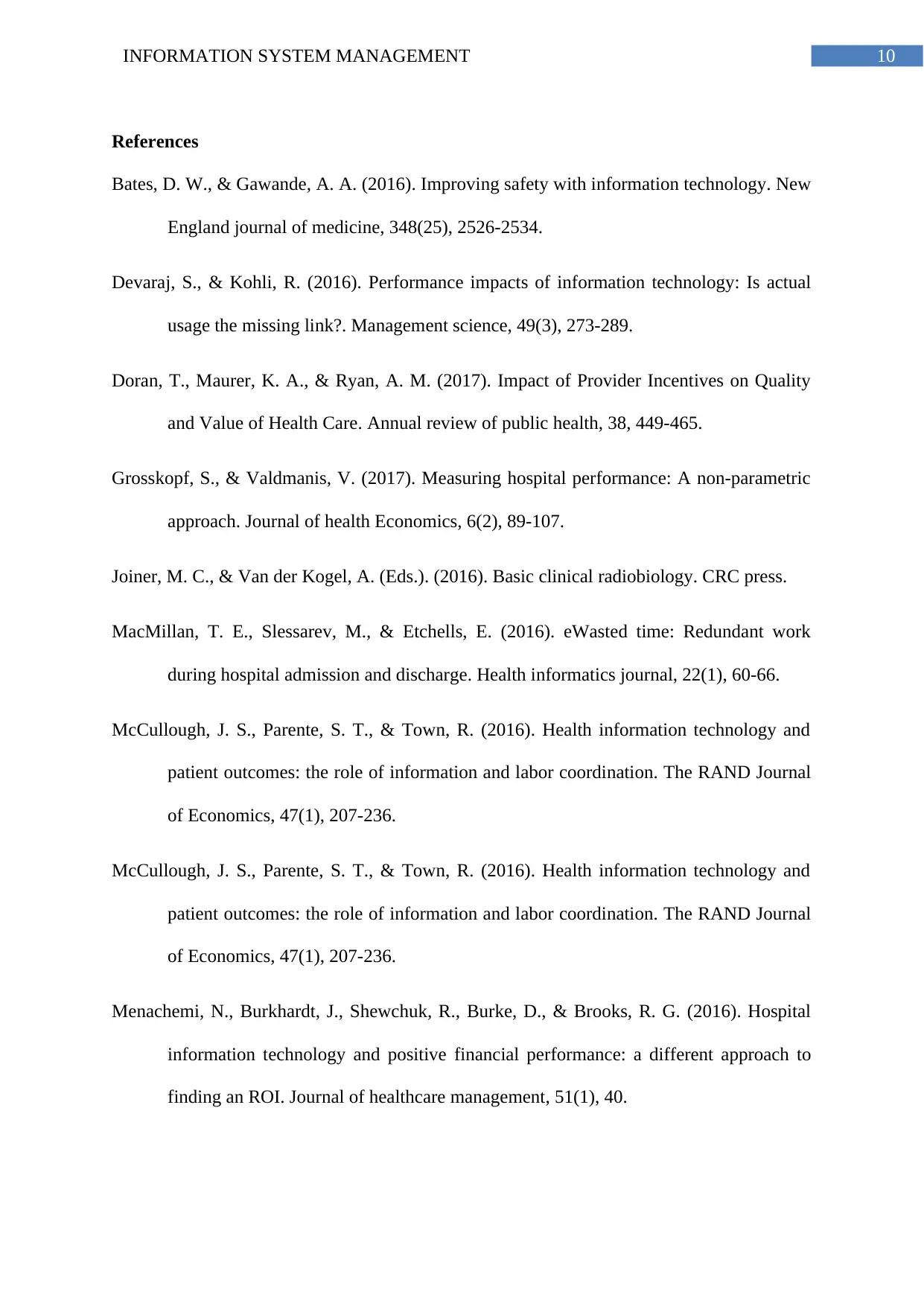
10INFORMATION SYSTEM MANAGEMENT
References
Bates, D. W., & Gawande, A. A. (2016). Improving safety with information technology. New
England journal of medicine, 348(25), 2526-2534.
Devaraj, S., & Kohli, R. (2016). Performance impacts of information technology: Is actual
usage the missing link?. Management science, 49(3), 273-289.
Doran, T., Maurer, K. A., & Ryan, A. M. (2017). Impact of Provider Incentives on Quality
and Value of Health Care. Annual review of public health, 38, 449-465.
Grosskopf, S., & Valdmanis, V. (2017). Measuring hospital performance: A non-parametric
approach. Journal of health Economics, 6(2), 89-107.
Joiner, M. C., & Van der Kogel, A. (Eds.). (2016). Basic clinical radiobiology. CRC press.
MacMillan, T. E., Slessarev, M., & Etchells, E. (2016). eWasted time: Redundant work
during hospital admission and discharge. Health informatics journal, 22(1), 60-66.
McCullough, J. S., Parente, S. T., & Town, R. (2016). Health information technology and
patient outcomes: the role of information and labor coordination. The RAND Journal
of Economics, 47(1), 207-236.
McCullough, J. S., Parente, S. T., & Town, R. (2016). Health information technology and
patient outcomes: the role of information and labor coordination. The RAND Journal
of Economics, 47(1), 207-236.
Menachemi, N., Burkhardt, J., Shewchuk, R., Burke, D., & Brooks, R. G. (2016). Hospital
information technology and positive financial performance: a different approach to
finding an ROI. Journal of healthcare management, 51(1), 40.
References
Bates, D. W., & Gawande, A. A. (2016). Improving safety with information technology. New
England journal of medicine, 348(25), 2526-2534.
Devaraj, S., & Kohli, R. (2016). Performance impacts of information technology: Is actual
usage the missing link?. Management science, 49(3), 273-289.
Doran, T., Maurer, K. A., & Ryan, A. M. (2017). Impact of Provider Incentives on Quality
and Value of Health Care. Annual review of public health, 38, 449-465.
Grosskopf, S., & Valdmanis, V. (2017). Measuring hospital performance: A non-parametric
approach. Journal of health Economics, 6(2), 89-107.
Joiner, M. C., & Van der Kogel, A. (Eds.). (2016). Basic clinical radiobiology. CRC press.
MacMillan, T. E., Slessarev, M., & Etchells, E. (2016). eWasted time: Redundant work
during hospital admission and discharge. Health informatics journal, 22(1), 60-66.
McCullough, J. S., Parente, S. T., & Town, R. (2016). Health information technology and
patient outcomes: the role of information and labor coordination. The RAND Journal
of Economics, 47(1), 207-236.
McCullough, J. S., Parente, S. T., & Town, R. (2016). Health information technology and
patient outcomes: the role of information and labor coordination. The RAND Journal
of Economics, 47(1), 207-236.
Menachemi, N., Burkhardt, J., Shewchuk, R., Burke, D., & Brooks, R. G. (2016). Hospital
information technology and positive financial performance: a different approach to
finding an ROI. Journal of healthcare management, 51(1), 40.
Paraphrase This Document
Need a fresh take? Get an instant paraphrase of this document with our AI Paraphraser
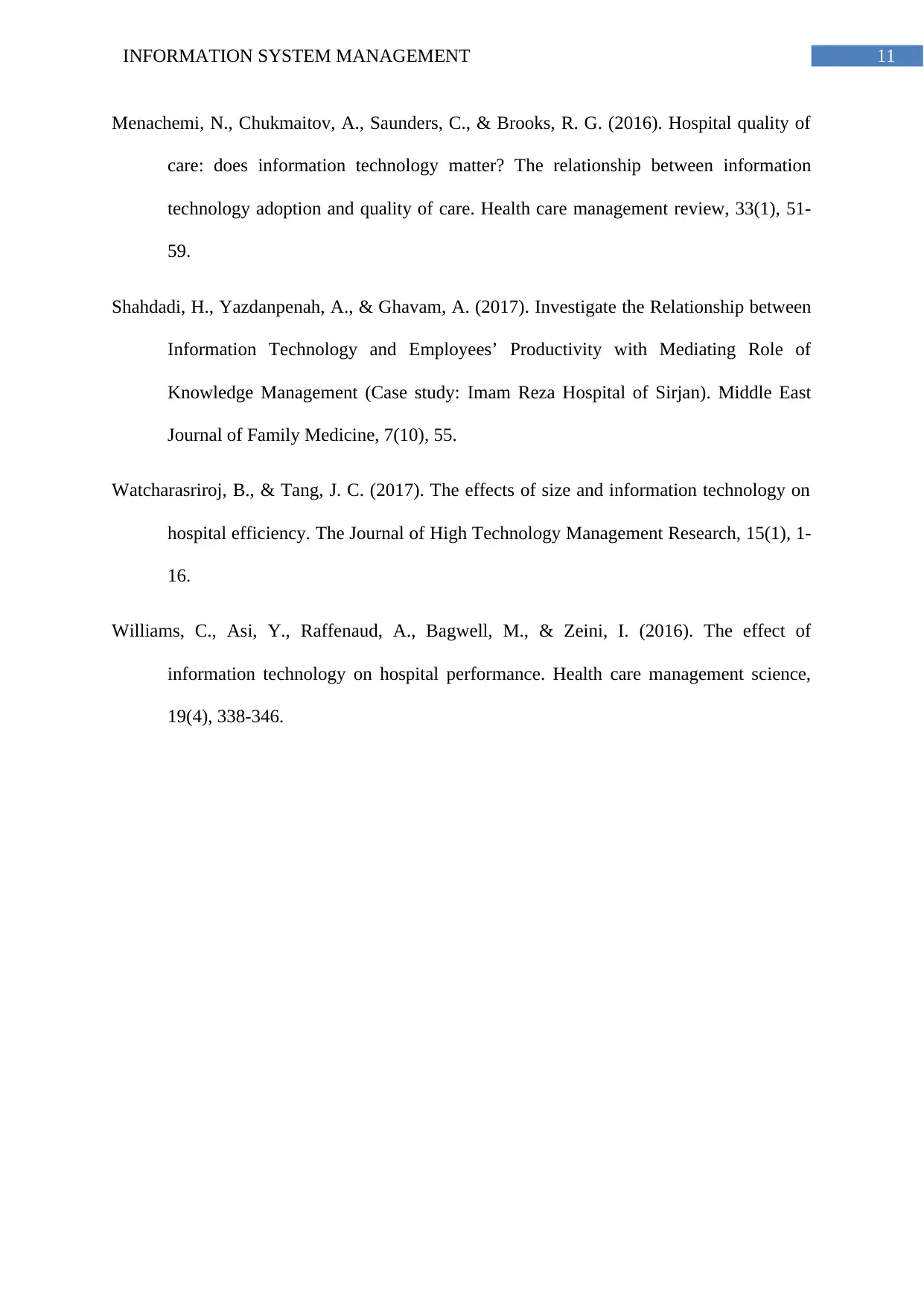
11INFORMATION SYSTEM MANAGEMENT
Menachemi, N., Chukmaitov, A., Saunders, C., & Brooks, R. G. (2016). Hospital quality of
care: does information technology matter? The relationship between information
technology adoption and quality of care. Health care management review, 33(1), 51-
59.
Shahdadi, H., Yazdanpenah, A., & Ghavam, A. (2017). Investigate the Relationship between
Information Technology and Employees’ Productivity with Mediating Role of
Knowledge Management (Case study: Imam Reza Hospital of Sirjan). Middle East
Journal of Family Medicine, 7(10), 55.
Watcharasriroj, B., & Tang, J. C. (2017). The effects of size and information technology on
hospital efficiency. The Journal of High Technology Management Research, 15(1), 1-
16.
Williams, C., Asi, Y., Raffenaud, A., Bagwell, M., & Zeini, I. (2016). The effect of
information technology on hospital performance. Health care management science,
19(4), 338-346.
Menachemi, N., Chukmaitov, A., Saunders, C., & Brooks, R. G. (2016). Hospital quality of
care: does information technology matter? The relationship between information
technology adoption and quality of care. Health care management review, 33(1), 51-
59.
Shahdadi, H., Yazdanpenah, A., & Ghavam, A. (2017). Investigate the Relationship between
Information Technology and Employees’ Productivity with Mediating Role of
Knowledge Management (Case study: Imam Reza Hospital of Sirjan). Middle East
Journal of Family Medicine, 7(10), 55.
Watcharasriroj, B., & Tang, J. C. (2017). The effects of size and information technology on
hospital efficiency. The Journal of High Technology Management Research, 15(1), 1-
16.
Williams, C., Asi, Y., Raffenaud, A., Bagwell, M., & Zeini, I. (2016). The effect of
information technology on hospital performance. Health care management science,
19(4), 338-346.
1 out of 11
Related Documents
Your All-in-One AI-Powered Toolkit for Academic Success.
+13062052269
info@desklib.com
Available 24*7 on WhatsApp / Email
![[object Object]](/_next/static/media/star-bottom.7253800d.svg)
Unlock your academic potential
Copyright © 2020–2025 A2Z Services. All Rights Reserved. Developed and managed by ZUCOL.





